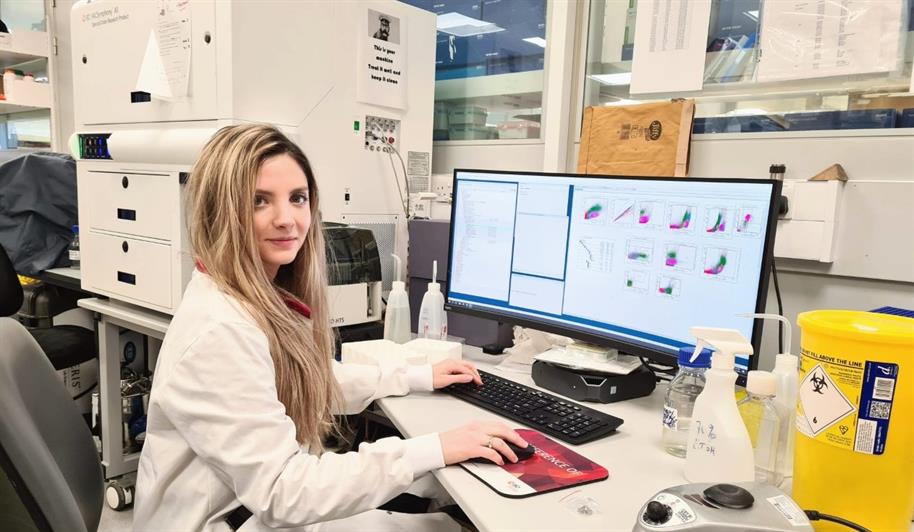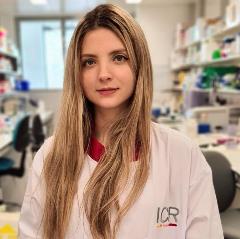
Image: Dr Vivian Dimou pictured with a flow cytometry machine which can help get valuable information about different immune cell populations in patient samples. Credit: Dr Vivian Dimou
The human body is a miraculous network of subcellular and cellular structures, leading to the formation of various tissues and organs, all together creating a highly complex organism. For all tissues and organs of the human body, there are three main cell types responsible for their proper and smooth function: the native tissue- and organ-specific cells along with their surrounding microenvironment, the endothelial and epithelial cells forming the blood vessels responsible for proper blood circulation, and last but not least, the immune cells. The latter, can be described as the ‘big nomads’ because following exposure to various stimuli they migrate towards tissues where they exert unique, highly differential immune responses.
The key role of immune cells
The immune cells play a catalytic role in modifying and shaping their local microenvironments. They can secrete pro-inflammatory or anti-inflammatory factors, compete with other immune cells to block their effective tissue infiltration, and confer a protective or damaging effect depending on their numbers, functions and prevalence within organs and tissues. So immune cells form every human’s ‘immunoverse’, and can be the game changers that will determine the potential outcome in various diseases and, very importantly, in cancer.
Cancer and immune cells
It was in 1863 when doctor and biologist Rudolph Virchow identified the presence of leukocytes in cancerous tissues, making for the first time the connection between inflammation and cancer. Since then and especially during the last two decades, chronic inflammation and deregulated immune cell balance have been shown time and again to be crucial hallmarks of cancer development and survival not only in blood cancers but also in most solid tumours. Practically, it is safe to say that there is no cancer without immune system involvement, just as there is no smoke without fire.
Solid tumour sites are under the influence of an ‘immunosuppressive regime’. The masters of this regime are traitorous immune cells aiding tumour cell evasion from surveillance, such as regulatory T cells, tumour-associated macrophages and myeloid-derived suppressor cells. Those dark masters together with the tumour cells are plotting to stop the Three Musketeers of our immune system – the cytotoxic T cells, the helper T cells and the natural killer cells – from efficiently infiltrating and launching a formidable attack on the tumour site.
They also aim to stop our dendritic cells (the fourth Musketeer, or D’Artagnan of the immunoverse), from doing their jobs as highly reputed tissue patrollers and professional antigen-presenters who would otherwise aid their fellow T cell Musketeers to recognise cancerous antigens.
As the “One for all, all for one” motto states, for their optimal function our 3+1 Musketeers need to establish a strong communication network with each other, something that is very hard to happen in cancer. One of the immunosuppressive regime’s strongest weapons is increased expression of checkpoint proteins such as PD-L1, PD1 and CTLA-4, which disrupt the function of our Musketeers, especially the T cells – ultimately promoting a state of anergy and reduced tumour infiltration.
The brave new world of immunotherapies
As the immunoverse has come to the forefront of cancer research, unprecedented progress has been made during the last decade in the use of novel immunotherapies in clinic. Humanised or fully-human monoclonal antibodies can act as immune checkpoint inhibitors, targeting the immunosuppressive regime’s weapons (PD-1/PD-L1, CTLA-4). These immunotherapies have, since 2011, been central in treating patients with lung cancer, melanoma, Hodgkin lymphoma, and head and neck, stomach, kidney, colon, and liver cancers, among others.
Furthermore, since 2017 significant advances in chimeric antigen receptor T cell (CAR-T) immunotherapies have been made, revolutionising the treatment of blood cancers. CAR-T cells, derived directly from the patients, are literally ‘living drugs’, an enhanced form of the natural cytotoxic T cell Musketeers, redirected for targeted killing against tumour cells overexpressing specific antigens.
The miraculous performance of these treatments in blood cancers has spurred huge scientific interest across the globe in the development and targeted delivery of CAR-T cell immunotherapies against aggressive solid tumours with often limited therapeutic options. And when it comes to immunotherapies, there is no limit to the imagination – from novel CAR-T cells and immune checkpoint inhibitors, to oncolytic viruses and dendritic cell-based vaccines, scientists and clinicians never stop working towards developing new, sophisticated immunotherapies.
The future lies in the immunoverse
Despite the huge progress of immunotherapies, patient responses in clinic are still far from perfect and can significantly vary. More often than not, the number of non-responders is overwhelmingly higher than that of the responders. So the next decade of immuno-oncology research will see researchers taking a dive deeper than ever into the immunoverse, to victoriously face the challenge of successfully picking out those patients who are most likely to respond.
Patient-derived blood and tumour tissue samples are the most precious sources of vital information about the exact composition of patients’ immune landscape. To effectively analyse these samples in the future, large-scale multi-colour flow cytometry, imaging, proteomic and genomic analyses will be performed on a regular basis as routine procedures. Such work could allow for a holistic approach to the big questions: What does patients’ immunoverse look like? How will it affect their responses to immunotherapies? How can we predict these responses?”
Recently, the ex vivo development of patient-derived organoids and the in vitro culture of precision-cut live tumour slices generated from human tumour tissue samples have been steadily gaining ground, thanks to the amazing results they can provide in predicting patient responses to different therapeutic regimens.
Organoids and tumour slices can offer scientists a unique and formidable tool to rationally guide the selection of optimal therapeutic treatments in clinic, tailored to the needs of each patient.
It might take years to fully unravel the wonders of the immunoverse, which, will probably always find ways to surprise us. Nonetheless, this journey is definitely one worth following until the end and sure to offer us countless spectacular moments on the way. Harnessing the full potential of the immunoverse, if successful, would tip the scales in our favour in our longstanding battle with cancer.
This piece is shortlisted for the 2021 Mel Greaves Science Writing Prize.
Read more entries from the finalists
 Dr Vivian Dimou is from Halkida, Greece. She undertook her undergraduate degree in Molecular Biology & Genetics in Greece. She then moved to the UK, where she completed my PhD in autoimmunity and childhood lupus nephritis at the University of Liverpool. In 2018, she moved to London and undertook her first postdoc at St George’s University of London.
Dr Vivian Dimou is from Halkida, Greece. She undertook her undergraduate degree in Molecular Biology & Genetics in Greece. She then moved to the UK, where she completed my PhD in autoimmunity and childhood lupus nephritis at the University of Liverpool. In 2018, she moved to London and undertook her first postdoc at St George’s University of London.
Her work was focused on immuno-phenotyping blood samples from patients with acute coronary syndrome and atrial fibrillation, to investigate potential deregulations in the function of T cell populations.
Since March 2020, she has been a Postdoctoral Training Fellow in Dr Astero Klampatsa’s Thoracic Oncology Immunotherapy Group. The team is focused on studying mesothelioma, a rare and aggressive solid tumour primarily arising in the lung pleura, with limited therapeutic options so far. Her project is focused on exploring the mesothelioma immune landscape with the aim to identify novel immunotherapeutic targets.
comments powered by